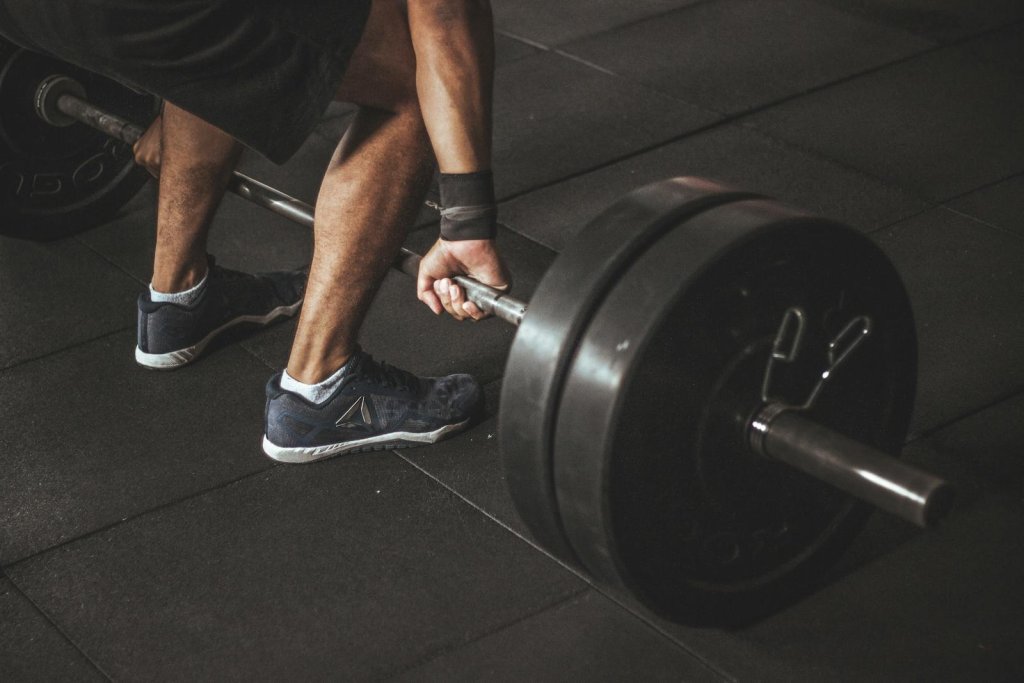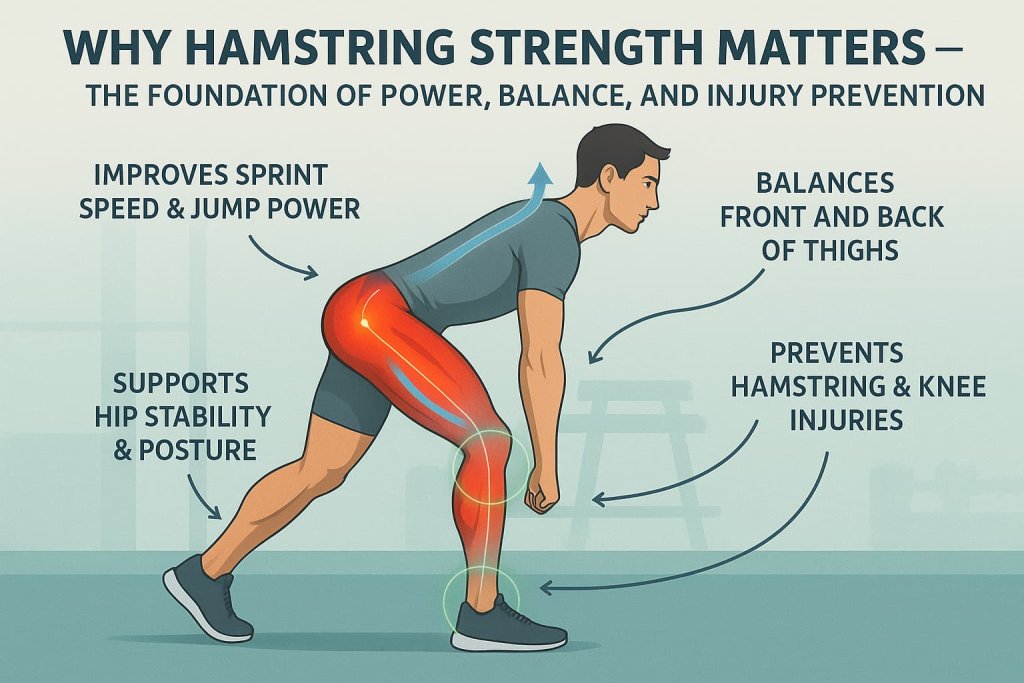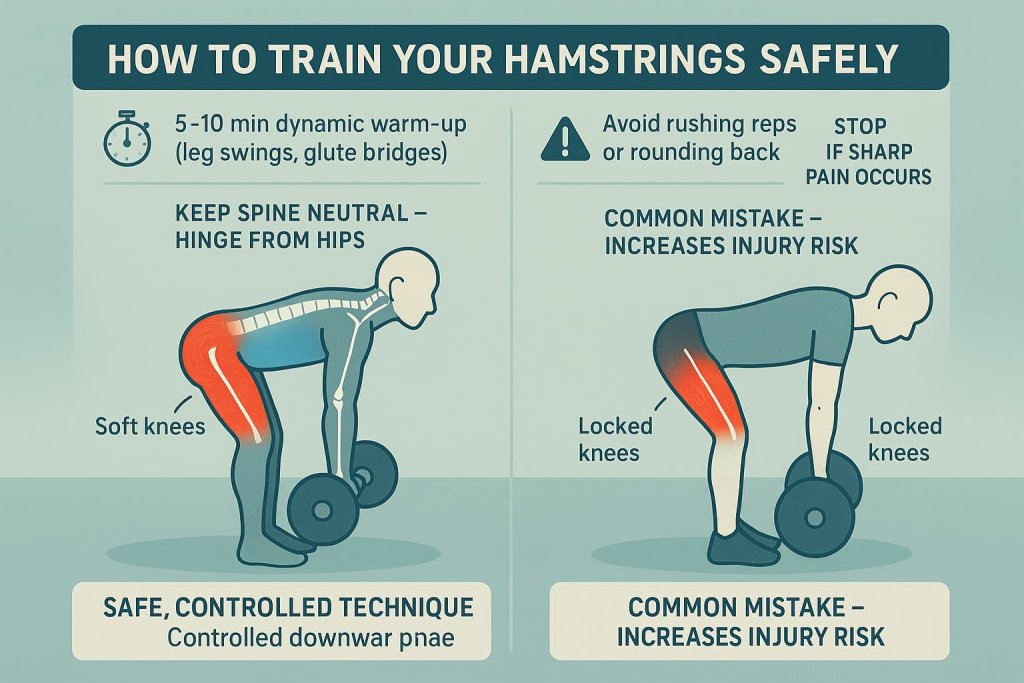The best hamstring exercises strengthen your posterior chain, improve athletic performance, and prevent injury. These muscles — running down the back of your thighs — are essential for sprinting, jumping, bending, and stabilizing your knees and hips.

Understanding how to properly train your hamstrings matters because weak or tight hamstrings are linked to lower-back strain, poor posture, and sports injuries. This guide explains 17 of the most effective hamstring exercises — supported by current research — to help you build strength, power, and functional balance safely.
Why Hamstring Strength Matters
The hamstrings consist of three muscles — biceps femoris, semitendinosus, and semimembranosus — that work together to extend your hips and flex your knees. They play a key role in running mechanics, posture, and lower-body coordination.

Strong hamstrings:
- Enhance sprint speed and jump height.
- Improve hip stability and posture.
- Prevent hamstring and knee injuries.
- Support balance between the front and back of your thighs (reducing risk of muscle imbalances).
A 2024 review in Frontiers in Sports and Active Living found that hip-dominant hamstring exercises (like Romanian deadlifts) promote better muscle hypertrophy and sprint performance compared to knee-dominant exercises alone.
Anatomy of the Hamstrings

The hamstrings are three muscles at the back of your thighs — biceps femoris, semitendinosus, and semimembranosus. They bend the knees, extend the hips, and stabilize the pelvis. Weak or tight hamstrings can cause poor posture, back strain, or knee pain, so balanced strength and flexibility are essential.
Trainer Tip: Train both hip-dominant (deadlifts) and knee-dominant (leg curls) moves for complete development.
How to Train Your Hamstrings Safely
Warm up before heavy training and focus on control over load.

Do:
- 5–10 min dynamic warm-up (leg swings, glute bridges).
- Keep a neutral spine and soft knees.
- Control the lowering phase for better strength gains.
Don’t:
- Rush reps or lift with a rounded back.
Trainer Tip: Stop immediately if you feel sharp pain; gradual progression prevents strain.
17 Best Hamstring Exercises
These 17 hamstring exercises target every part of your posterior chain — from power-focused hip hinges to controlled knee flexion moves. Combine 2–3 of them per session to build stronger, more balanced, and injury-resistant legs.
1. Romanian Deadlift (RDL)
Why it works:
The Romanian Deadlift is one of the most effective hip-hinge movements for building posterior-chain strength. It trains the hamstrings in their lengthened state, improving both muscle growth and flexibility. By emphasizing the eccentric (lowering) phase, it enhances hamstring control, spinal stability, and posture.
Muscles worked:
Biceps femoris, semitendinosus, semimembranosus, gluteus maximus, erector spinae, adductor magnus (assistive).
How to do it:
- Stand tall with feet hip-width apart and barbell or dumbbells in front of your thighs.
- Keep knees slightly bent, hinge your hips backward while maintaining a flat back.
- Lower the weight until you feel a strong stretch in the hamstrings (usually mid-shin).
- Drive hips forward and squeeze glutes to return upright.
- Maintain tension — avoid bouncing or locking your knees.
Trainer Tip:
Think “hips back, not down.” Keep your spine neutral and shoulders pulled slightly back. Move slowly during the lowering phase for better muscle activation and injury prevention.
2. Nordic Hamstring Curl
Why it works:
The Nordic Curl is the gold standard for hamstring injury prevention. It focuses on eccentric strength — controlling the muscle as it lengthens. Studies show that athletes who incorporate Nordics can cut hamstring injury rates by up to 70% (British Journal of Sports Medicine, 2023). This makes it a staple for runners, soccer players, and strength athletes.
Muscles worked:
Semitendinosus, semimembranosus, biceps femoris (long head).
How to do it:
- Kneel on a soft mat with ankles secured under a sturdy object or by a partner.
- Cross arms over chest or hold them by your sides.
- Slowly lean forward from the knees, keeping your body straight from head to knees.
- Catch yourself with your hands at the bottom and gently push back to the start.
Trainer Tip:
Emphasize a slow, controlled lowering — that’s where most strength gains occur. Perform only 2–4 reps per set, focusing on quality over quantity.
3. Glute-Ham Raise (GHR)
Why it works:
This advanced move trains the hamstrings through both hip extension and knee flexion — a rare combination. It builds strength across the full range of motion and enhances sprint acceleration and jumping power.
Muscles worked:
Hamstrings (all three heads), gluteus maximus, erector spinae, calves (as stabilizers).
How to do it:
- Secure your feet under a GHR machine or partner-assisted pad.
- Start with your body upright, thighs pressed against the pad.
- Lower yourself forward by bending at the knees and hips.
- Contract your hamstrings and glutes to return to the upright position.
Trainer Tip:
Avoid hyperextending your back. Control every inch of movement — this is a strength builder, not a momentum exercise.
4. Stability Ball Hamstring Curl
Why it works:
This functional bodyweight exercise enhances hamstring and glute strength while challenging your core and balance. It’s ideal for beginners or rehabilitation phases since it limits spinal load.
Muscles worked:
Hamstrings, gluteus maximus, abdominals, hip stabilizers.
How to do it:
- Lie flat on your back, arms at your sides, and heels on a stability ball.
- Lift your hips until your body forms a straight line from shoulders to feet.
- Roll the ball toward you by bending your knees and squeezing your hamstrings.
- Extend your legs slowly to return to the starting position.
Trainer Tip:
Keep hips lifted the entire time for maximum engagement. If the exercise feels too easy, perform it one leg at a time.
5. Kettlebell Swing
Why it works:
A dynamic movement that develops explosive hip power while strengthening hamstrings, glutes, and lower back. It improves athleticism and metabolic conditioning — making it a powerhouse for both strength and fat-burning goals.
Muscles worked:
Hamstrings, gluteus maximus, erector spinae, core, shoulders (stabilization).
How to do it:
- Stand with feet shoulder-width apart and kettlebell between your legs.
- Hinge at the hips to swing the kettlebell back, then explosively extend your hips forward.
- Let the kettlebell rise to chest height, guided by momentum.
- Control the downswing and repeat rhythmically.
Trainer Tip:
Drive from the hips — not the arms. Keep your chest up and core tight to prevent rounding your lower back.
6. Good Morning
Why it works:
The Good Morning strengthens the hamstrings and spinal stabilizers through controlled hip flexion. It’s excellent for teaching hinge mechanics and preventing lower-back weakness.
Muscles worked:
Hamstrings, glutes, erector spinae, adductor magnus.
How to do it:
- Position a barbell across your shoulders (like a back squat).
- With a slight knee bend, hinge forward at the hips until your torso is nearly parallel to the floor.
- Contract hamstrings and glutes to return upright.
Trainer Tip:
Start with a light barbell to master technique. Keep your chest lifted and back flat — not rounded.
7. Single-Leg Romanian Deadlift
Why it works:
Enhances balance, coordination, and unilateral strength. This exercise helps correct imbalances between legs and activates stabilizer muscles around the hips and ankles.
Muscles worked:
Hamstrings, glutes, lower back, core stabilizers.
How to do it:
- Hold a dumbbell in your right hand and stand on your left leg.
- Hinge forward, extending your right leg straight behind you.
- Lower until your torso and leg form a straight line, then return upright.
Trainer Tip:
Move slowly and focus on alignment. If balance is challenging, perform it barefoot to strengthen your stabilizers.
8. Hamstring Walkout
Why it works:
Teaches controlled lengthening under tension, improving endurance and proprioception in the hamstrings and glutes.
Muscles worked:
Hamstrings, glutes, abdominals.
How to do it:
- Lie on your back with knees bent, feet flat, and arms by your sides.
- Lift hips into a bridge.
- Slowly walk your feet forward until legs are nearly straight.
- Reverse the movement without dropping hips.
Trainer Tip:
Maintain constant tension — your hips should never touch the floor.
9. Cable Pull-Through
Why it works:
Teaches proper hip extension mechanics while minimizing spinal compression. It’s a joint-friendly way to strengthen the hamstrings.
Muscles worked:
Hamstrings, glutes, erector spinae, core.
How to do it:
- Attach a rope to a low cable pulley and face away from the machine.
- Step forward slightly, hinge at the hips, and let the cable pull your hands through your legs.
- Extend hips forward, squeezing glutes and hamstrings at the top.
Trainer Tip:
Keep your arms straight — think “hips move, arms follow.”
10. Seated or Prone Leg Curl
Why it works:
This isolation exercise allows full focus on knee flexion — the hamstrings’ primary function. It’s a proven hypertrophy builder.
Muscles worked:
Biceps femoris, semitendinosus, semimembranosus.
How to do it:
- Adjust the machine pad just above your heels.
- Curl legs toward your glutes while exhaling.
- Slowly return to start with control.
Trainer Tip:
Squeeze hard at the top and slow down the lowering phase — that’s where the muscle develops most.
11. Reverse Hyperextension
Why it works:
An elite strength and rehabilitation tool that strengthens the posterior chain while decompressing the lower back.
Muscles worked:
Hamstrings, glutes, lower back.
How to do it:
- Lie face down on a reverse hyper machine or high bench.
- Raise your legs until they align with your torso, then lower slowly.
Trainer Tip:
Don’t swing. Pause at the top and focus on contracting the glutes and hamstrings.
12. Sliding Leg Curl (Towel or Slider)
Why it works:
This floor-based move develops hamstring strength through a long range of motion. It’s a great low-impact alternative when equipment is limited.
Muscles worked:
Hamstrings, glutes, core.
How to do it:
- Lie on your back with feet on sliders or towels.
- Lift hips into a bridge and slide heels toward your glutes.
- Extend legs back slowly without losing hip height.
Trainer Tip:
Go slow — controlling the slide engages the hamstrings through every inch.
13. Dumbbell Hip Thrust
Why it works:
Enhances hip extension power — crucial for sprinting and jumping. It’s also excellent for glute and hamstring hypertrophy.
Muscles worked:
Gluteus maximus, hamstrings, quadriceps (assistive).
How to do it:
- Sit with upper back against a bench and a dumbbell on your hips.
- Drive hips upward until thighs and torso are parallel to the floor.
- Lower slowly while maintaining control.
Trainer Tip:
Tuck your chin slightly and keep ribs down — avoid overarching your spine.
14. Lying Dumbbell Leg Curl
Why it works:
A free-weight variation that isolates and strengthens the hamstrings with increased stabilization demand.
Muscles worked:
Biceps femoris, semitendinosus, semimembranosus.
How to do it:
- Lie face down on a flat bench, holding a dumbbell between your feet.
- Curl heels toward your glutes, pause, then lower under control.
Trainer Tip:
Keep thighs pressed into the bench to prevent momentum.
15. 45-Degree Back Extension
Why it works:
Reinforces spinal stability and strengthens the posterior chain at a functional angle. Improves posture and athletic hip extension.
Muscles worked:
Hamstrings, glutes, erector spinae.
How to do it:
- Set the pad at hip height on a back-extension bench.
- Cross arms over your chest.
- Lower torso slowly, then raise until in line with your legs.
Trainer Tip:
Stop at neutral — avoid arching beyond the spine’s natural curve.
16. Banded Romanian Deadlift
Why it works:
Offers joint-friendly variable resistance — easier at the bottom, harder at the top. It’s ideal for home workouts or deload phases.
Muscles worked:
Hamstrings, glutes, lower back.
How to do it:
- Stand on a resistance band and hold its ends near your hips.
- Hinge at the hips, keeping a flat back.
- Return upright by driving hips forward and squeezing glutes.
Trainer Tip:
Keep constant tension — don’t let the band slacken.
17. Sprinting or Hill Sprints
Why it works:
Sprinting activates the hamstrings up to 100%, according to EMG studies. Hill sprints reduce injury risk while building strength, coordination, and explosive power.
Muscles worked:
Hamstrings, glutes, calves, hip flexors, quads.
How to do it:
- Warm up with light jogging and dynamic stretches.
- Sprint 20–40 meters on a moderate incline.
- Rest 60–90 seconds and repeat 5–8 times.
Trainer Tip:
Drive knees high and extend fully through the hips. Hill sprints teach power safely by reducing eccentric load.
Programming Tips
- Frequency: Train hamstrings 2–3 times per week.
- Sets/Reps: 3–4 sets of 8–12 reps for strength; 12–15 for endurance.
- Progression: Combine hip-dominant and knee-dominant moves.
- Warm-Up: Always include dynamic stretches (leg swings, bridges).
How Often to Train Hamstrings
Most people see best results with 2–3 sessions per week, leaving at least 48 hours between workouts.
- Beginners: 1–2 sessions weekly, focus on form.
- Intermediate/Advanced: Alternate hip- and knee-dominant days.
Trainer Tip: Recovery drives growth—prioritize rest, sleep, and good nutrition.
Common Mistakes to Avoid
- Rounding your back during RDLs.
- Using momentum instead of muscle control.
- Ignoring single-leg work.
- Skipping warm-ups or recovery days.
Trainer Tip: Precision beats heavy loading—move slowly, feel each rep, and keep posture aligned.
Safety & Precautions
- Warm up with light cardio and mobility work.
- Avoid overloading early — focus on form and control.
- Stretch after training to maintain flexibility.
- Consult a doctor or physiotherapist if you have hamstring strain or chronic pain.
FAQs
1. What’s the best hamstring exercise for beginners?
Start with stability ball curls or bodyweight bridges to learn control.
2. How often should I train hamstrings?
Two to three times weekly is effective for most lifters.
3. Do hamstring exercises help posture?
Yes. Strong hamstrings reduce anterior pelvic tilt and lower-back strain.
4. Should I train hamstrings and quads together?
Yes, balance both to prevent imbalances that can cause knee issues.
5. Are hamstring curls enough?
They’re good isolation moves but should be paired with hip-dominant lifts for full development.
6. Can I do hamstring training at home?
Yes — bodyweight bridges, sliders, and single-leg RDLs work great without equipment.
7. How long until I see results?
Consistency for 6–8 weeks usually yields visible and measurable strength improvements.
Conclusion
Strong hamstrings are the foundation of athletic movement and lower-body balance. Whether you’re training for performance, aesthetics, or injury prevention, incorporating a mix of hip- and knee-dominant hamstring exercises ensures full development.
Start with 2–3 of these 17 exercises per session — your posterior chain will thank you.
References
- Evidence-Based Hamstring Injury Prevention & Risk Factors: Systematic Review & Meta-analysis (Am J Sports Med, 2023) — High-quality synthesis on what actually reduces hamstring injuries (supports your safety and programming sections).
- Muscle Activation During Various Hamstring Exercises (J Strength Cond Res, 2014) — EMG comparison of RDL, Good Morning, GHR, and Leg Curl (guides exercise selection: hip- vs knee-dominant).
- Comparison of Hamstring Muscle Activation During Common Exercises vs Sprinting (Frontiers in Physiology, open-access) — Benchmarks exercise EMG against sprinting (context for “sprinting/hill sprints” and activation ceilings).
- Hamstring Myoelectrical Activity During Three Different Kettlebell Swings (J Strength Cond Res, 2020) — Shows hip-hinge swing style maximizes hamstring EMG (supports your Kettlebell Swing section).
- ACE-Sponsored Lab Study: Which Hamstrings Exercises Yield the Best Results? (ACE Fitness) — Practitioner-friendly summary highlighting kettlebell swings, single-leg RDLs, and prone curls (good for in-body external link).
- Sprint Specificity of Isolated Hamstring-Strengthening Exercises (Frontiers in Sports & Active Living, 2021) — Connects exercise force orientation with sprint performance transfer (justifies hinge-power emphasis).
- Hamstrings Hypertrophy Is Specific to the Training Exercise (Med Sci Sports Exerc, 2024) — New evidence that hip-dominant long-length work can outgain NHE for overall hamstring/BFlh hypertrophy (informs your programming tips).
